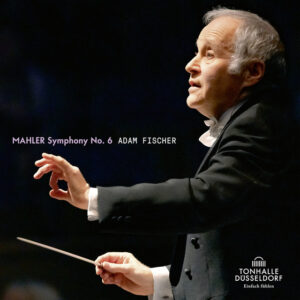GRAMOPHONE Review: Mahler Symphony No. 6 – Düsseldorfer Symphoniker/Fischer
 This final chapter of Adam Fischer’s distinctive, occasionally inspired, Mahler cycle draws to a close dare I say that it is nothing if not fatalistic that the traumatic Sixth should have coincided with the start of the pandemic. Mahler would certainly have bought into the irony. The three live performances which make up this recording were indeed the last to be given before a live audience in Dusseldorf prior to lockdown. If a sense of foreboding was not apparent in the performance we’d be asking why.
This final chapter of Adam Fischer’s distinctive, occasionally inspired, Mahler cycle draws to a close dare I say that it is nothing if not fatalistic that the traumatic Sixth should have coincided with the start of the pandemic. Mahler would certainly have bought into the irony. The three live performances which make up this recording were indeed the last to be given before a live audience in Dusseldorf prior to lockdown. If a sense of foreboding was not apparent in the performance we’d be asking why.
There is certainly an urgency in Fischer’s first movement: impulsive, forthright, but dug-in too. His tempo is not dissimilar to Bernstein though I wish Fischer had adopted some of his affecting rubato where the second subject – the so-called ‘Alma’ theme – is at full-throttle with horns in descant. It’s all a bit ‘straight’ – shiny and bright for sure but not ‘dirty’ enough for me.
The central departure to higher climes (mit cowbells) is magical, especially the passage for solo horn and solo violin, and here Fischer does allow himself a moment to stand back and breathe the rarefied air. And yet when that mind-numbing march returns in grisly double basses the moment goes for absolutely nothing. For sure the march now assumes an angrier resolve and I’ve no complaints about its determination to achieve a major-key resolution – the gigantic suspension (no mistaking it) midway through the coda does land mightily – but still we need to feel more of the black remorselessness of it all.
The liner notes for this edition are super-comprehensive about the symphony’s various editions and talking points and as ever Fischer adds his personal observations. Inevitably the arguments for and against the ordering of the middle movements take centre-stage along with Fischer’s decision (according to the note writer) to play them in the revised order (Andante first, Scherzo second) for the live performances but reverse them for the recording as a way of pointing up that both options have merit. For whatever reason that hasn’t happened. The recording presents the revised order (sigh) and regular readers know exactly how I feel about that.
How much more unsettling is the frantic goose-stepping and minor key plunge of the scherzo immediately following the first movement. It’s one of Mahler’s most daring dramatic touches and why he lost his nerve about it is still something of a mystery to me. You’ll notice I am writing about the scherzo first in order to make the point yet again. Fischer, like Bernstein and Tennstedt, accentuates the halting grotesqueness of Mahler’s ‘old fashioned’ (his marking) rubatos. Braying horns and growling basses and tuba are darkly characterised.
I just can’t buy into the faux tranquillity of the Andante as some kind of healing salve after the first movement. It’s true that a deep and abiding ache pervades this music and that Fischer is poignant and plain-speaking throughout with plangent wind solos –
but the instability and uncertainty of it is for me doubly affecting when it sits on the threshold of the finale.
The seismic upheavals therein are bravely chronicled by Fischer with a keen ear on the nightmarish colours – though it’s amazing how Bernstein (in his DG Vienna Philharmonic version) with his broader pacing of the opening paragraph manages to make the orchestration sound even more surreal and ‘contemporary’. But Fischer still packs a punch and chooses (superstition be damned) to give us all three hammer blows. Bernstein does, too, but rather naughtily places the last of them ten bars early where you might expect to hear it and not where Mahler actually placed it before deleting it.
Listening again to Bernstein (DG) and Tennstedt (the live Prom performance) in the trombone threnody of the coda it is clear to me why Fischer’s rather ‘in tempo’ approach doesn’t quite bring the tragedy home. With Bernstein and Tennstedt defeat and exhaustion are explicit. It’s hard listening to either but it’s Bernstein for me.
You May Also Like

GRAMOPHONE Review: Shostakovich Symphony No. 11 ‘The Year 1905’ – BBC Philharmonic Orchestra/Storgårds
17/06/2020
A Conversation With ERIC WHITACRE
02/09/2010

